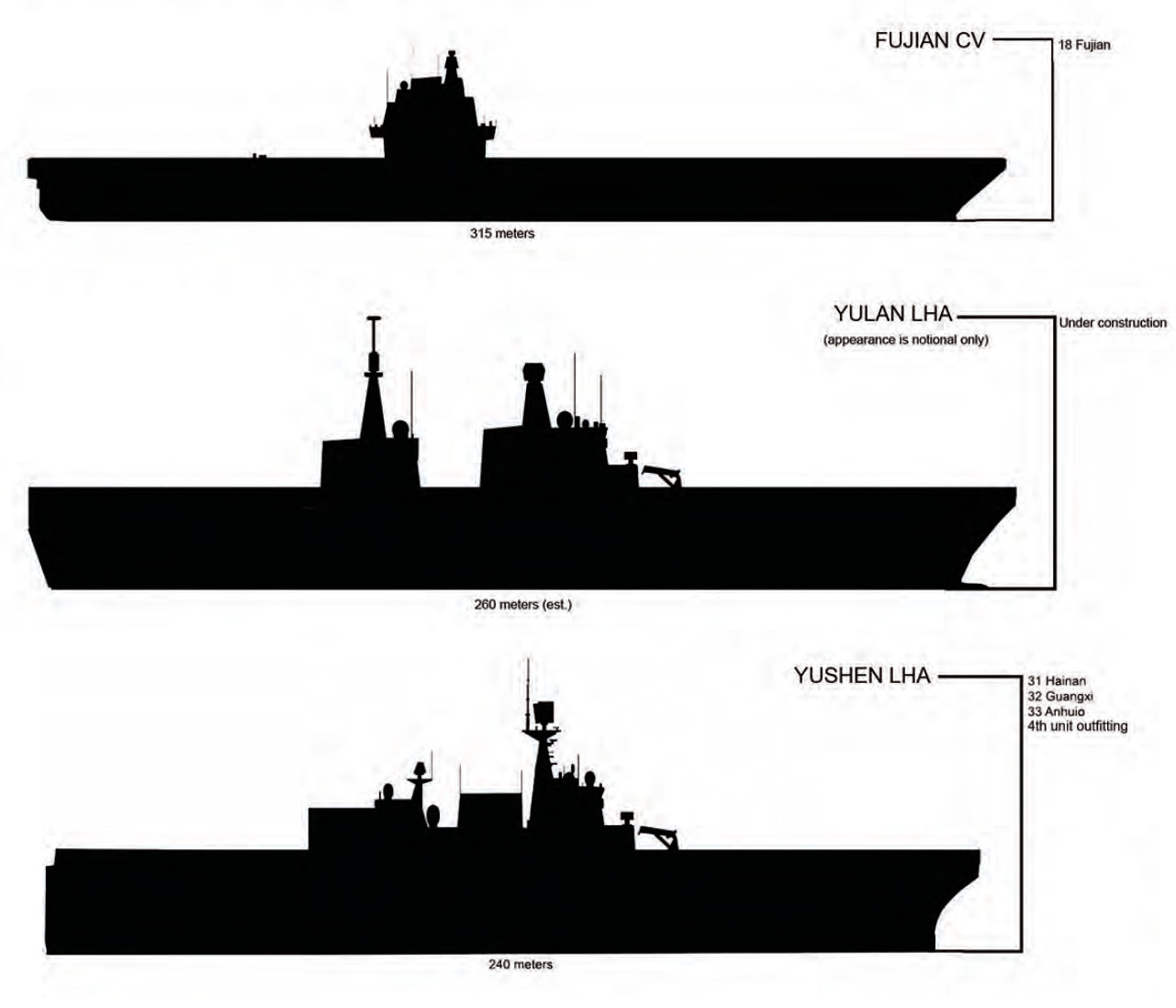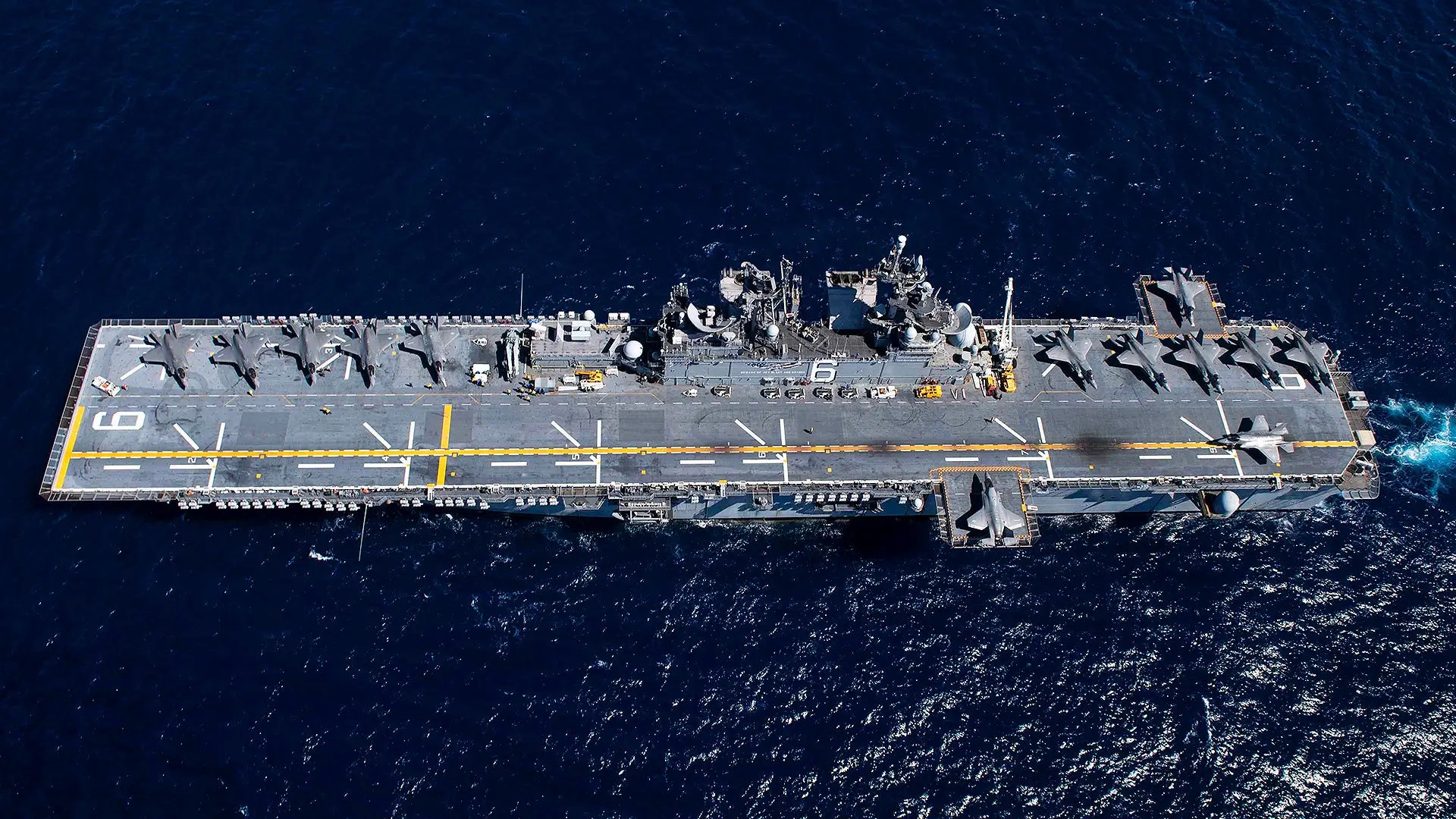The first example of a new class of Chinese warship with a large open flight deck, commonly referred to as the Type 076, is steadily taking shape. Generally described as an amphibious assault ship, there have long been reports that the vessel could feature catapults and arresting gear to support an air wing that includes uncrewed combat air vehicles (UCAV) and other fixed-wing drones.
Size-wise, satellite imagery already shows that the Type 076 is roughly in between China’s current largest amphibious warship, the Type 075, and the country’s newest and largest aircraft carrier, the Fujian. Most notable is the vessel’s width. Its flight deck is substantially wider than the Type 075 and other amphibious assault ships, which will give it a large deck area to work with.
The Type 076 is currently under construction in a yard on Changxing Island in Shanghai. The yard in question appears to be associated with the state-owned China State Shipbuilding Corporation’s (CSSC) Hudong-Zhonghua subsidiary. Hudong-Zhonghua has been responsible for building the existing Type 075s, three of which are in service now with a fourth under construction, and is in the process of relocating from another site in Shanghai to Changxing. Where the Type 076 is being built is also right next to the Jiangnan shipyard, one of CSSC’s most prominent shipbuilders where the Fujian was built.

Official details about the Type 076, which the U.S. military now also refers to as the Yulan class, remain limited. The first evidence that the PLAN was interested in such a ship emerged in 2020. The Type 076 moniker reflects reports that the design may be derived, at least in part, from existing the Type 075.
From what we can see now of the Type 076, which looks to have been under construction since around October 2023, it is a substantially larger vessel in all regards. A review of satellite imagery from Planet Labs indicates that it is roughly 864 feet long and 141 feet wide (263 and nearly 43 meters, respectively). By comparison, again based on satellite imagery, the Type 075 is 784 feet long and 105 feet wide (almost 239 and 32 meters), while the Fujian is 1,036 feet in length and 275 feet in width (close to 316 and almost 84 meters).

This is all in line with the assessments of the lengths of those three ship types as included in an unclassified PLAN ship recognition guide the U.S. Navy’s Office of Naval Intelligence (ONI) published earlier this year. Given its physical size, the Type 076 can be assumed to have a significantly larger displacement than the Type 075 (estimated to be between 35,000 and 40,000 tons with a full load), as well.

As another comparison, the Type 076 is similar in length to the U.S. Navy’s aviation-focused amphibious assault ship USS America, but is significantly wider. The America is 855 feet (260.7 meters) long and is 106 feet (32.3 meters) at its widest, according to the Navy.
The satellite imagery and other pictures taken from aircraft passing overhead that have emerged online show the general profile of the Type 076’s flight deck increasingly coming into view. It currently looks set to be entirely straight and to be squared off at the ends. The basic shape, as it is seen now, is similar in many respects to that of the Type 075. It is possible that the Type 076’s deck profile could still evolve as construction continues.
What may be a space for an aircraft elevator on the port side of the stern end of the Type 076’s is visible. This is a feature not found on the Type 075. Like its predecessor, the new amphibious assault ship does look to have another large elevator at the center of the stern.



Other details about the Type 076’s configuration remain limited. Reports from the 2020-2021 time frame have suggested that the ship could have electromagnetic catapults and arresting gear, and be optimized around a drone-centric air wing. Some existing large deck amphibious assault ships also feature ski jumps as another way of expanding the size and scope of aircraft they can support. Of course, the Type 076’s large open flight deck would primarily support all kinds of crewed and uncrewed helicopters.
At the Zhuhai Airshow in 2021, the state-run Aviation Industry Corporation of China (AVIC) also notably showed a video depicting a navalized derivative of the GJ-11 Sharp Sword stealthy unmanned combat air vehicle taking off from what looked at the time to be a Type 075 amphibious assault ship. That same video, seen in the social media post below, showed a group of GJ-11s swarming enemy surface warships and employing either electronic warfare systems or directed energy weapons, as well as air-launched decoys.
While the Type 076s could potentially carry fast jets, it is worth noting that, to date, there has been no indication that the Chinese are pursuing a short or vertical takeoff and landing capable tactical jet that would be well suited for use with a large amphibious assault ship. Lighter manned fixed-wing types remain a possibility.
Regardless, the potential value to the PLAN of having a fleet of very large deck amphibious assault ships that are highly capable of large-scale drone operations as well as traditional amphibious assaults is clear. These ships could be used to launch and recover UCAVs like the GJ-11 and other types of drones to perform a host of missions from maritime strike to intelligence, surveillance, and reconnaissance (ISR). They could be used to provide additional ‘mass’ in support of the operations of larger carrier strike groups and help to free the air wings of flattops like Fujian up for tasks they might be better suited for. In addition, they could provide a lower tier of naval aviation support that could be employed independently.
The PLAN’s interest in expanding its use of various tiers of drones from all of its big deck warships, including its full-size aircraft carriers, is well known. The War Zone has previously explored in detail why adding even unarmed stealth drones to China’s naval aviation capabilities makes good sense for extending the targeting capabilities and general sensor reach of friendly forces.
Simply having more naval aviation capacity overall would give the PLAN added flexibility for various operations closer to the mainland, including a potential military intervention against Taiwan or defending its expansive and largely unrecognized territorial claims in places like the South China Sea. Type 076s could also help project naval and air power further from China’s shores, something that has also been a driving factor behind the country’s broader carrier ambitions.
It’s also worth noting that the Chinese have been building various types of more specialized drone mothership vessels, ostensibly for training and testing purposes, but which could also have operational roles.
Whether or not the Type 076 has a rear well deck for launching and recovering landing craft also remains to be seen. Even without this feature, the ship could still perform various missions not exclusively centered around its aviation capabilities like delivering forces ashore during a variety of different contingency scenarios. The Type 076 could help provide support during humanitarian assistance and disaster relief operations. Big deck amphibious warfare ships, in general, provide their operators with immensely valuable platforms for projecting both hard and soft power.
In many ways, the Type 076 seems to reflect a debate about the configuration and the roles and missions of warships with large flight decks elsewhere around the world. The U.S. Navy’s aforementioned America class is a prime example of this. The Navy has two aviation-centric America class ships, which do not feature well decks, in service now. However, it also has three more examples in various stages of construction that will be members of a subclass that do feature a well deck and have other changes to balance the resulting loss of physical space for aviation-related activities.

On the other side of the equation, Japan has converted its amphibious assault ship JS Izumo to be able to operate F-35B Joint Strike Fighters and is in the process of putting its sister ship, JS Kaga, through the same aviation-focused modification process. The South Korean government had also announced plans for a light carrier loaded with F-35Bs back in 2020, but its carrier ambitions have significantly grown in the intervening years.
Last year, the Turkish Navy also commissioned the TCG Anadolu, a big deck amphibious assault ship with a ski jump at the front. There are now plans to optimize it for use more as a light drone carrier that could also potentially accommodate fixed-wing manned types. Other countries in Europe are now also looking at the idea of operating big deck amphibious warfare ships in similar roles.

However, as already noted, the Type 076 will be wider than the America class. It will also have a greater width than Japan’s Izumo class ships and Turkey’s Anadolu.
Overall, what can be seen of the Type 076’s configuration so far has started to draw very broad comparisons to aircraft carriers like the United Kingdom’s ski jump-equipped short and vertical takeoff and landing Queen Elizabeth class, in terms of potential deck layout. The Queen Elizabeth design is longer (932 feet or 284 meters) and substantially wider (240 feet or 73 meters) than the Type 076 is expected to be in the end.
The United Kingdom does also have plans to integrate assisted launch systems and recovery gear onto the Queen Elizabeth carriers. This plan is heavily centered on expanding the uncrewed component of the air wings of those ships, though STOBAR/CATOBAR configurations could open up the possibility of embarking new kinds of crewed aircraft, as well. You can read more about those particular plans here.
The Royal Navy has already been testing different drones, including General Atomics’ Mojave as seen in the video below, on the Queen Elizabeth class flattops in their present configurations.

The substantial progress that has been made on the construction of the Type 076 in the past eight months or so also speaks to China’s general shipbuilding capacity, which is notably exponentially greater than that of the United States. The War Zone has highlighted in the past how the speed with which the PLAN has been able to acquire Type 075s, the country’s largest in-service amphibious warfare ships, has been indicative of that service’s significant efforts to expand by the scale and scope of its capabilities in recent years. Since 2021, the PLAN has commissioned three Type 075s and a fourth example is now under construction.
With work on the Type 076 continuing apace, it may not be long before a clearer picture of what the ship’s final configuration will be emerges, offering new clues about its expected capabilities. From what we can already see, the design looks set to have a very wide open flight deck.
Contact the author: joe@twz.com
